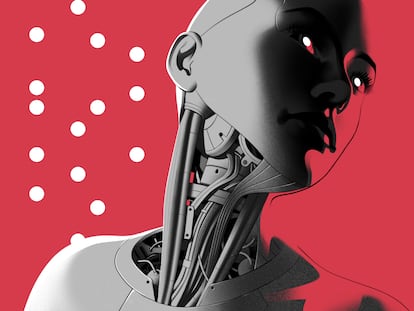My robot and I: Japanese stories of technology and old age
In the country with the highest life expectancy in the world — currently facing the crisis of an aging population — scientists, healthcare professionals and technology companies are coming together to fight against problems such as loneliness, cognitive deterioration and loss of mobility
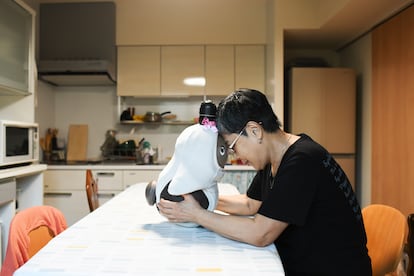
Mitigating loneliness, preventing cognitive decline and alleviating the loss of mobility are the priorities of the robotics field in Japan. For decades, the country has been searching for technological solutions to address the economic and social repercussions that stem from its rapidly aging population. Three robots — which are present in many Japanese nursing homes and hospitals for the elderly — aim to entertain, start conversations and create emotional connections. Their names are Pepper, AIBO and PARO. This technological trio accompanies the staff who care for the physical and mental well-being of more than 40 elderly people at the Shintomi Nursing Home, a long-term care facility in the center of Tokyo.
Pepper — the closest to a humanoid among the so-called “social robots” produced in Japan — has a height of four feet and moves on a base that makes it look like a huge white chess piece. Twice a week, Pepper is scheduled to play songs (which were popular 50 years ago) in front of about 20 elderly people. The android compensates for its lack of facial expressions with agile arm movements. The fluidity of its articulations confirms its pedigree as the successor to a lineage of industrial robots that, since the end of the 20th century, has maintained Japan as the world’s leading exporter of factory automation systems.
From their seats, residents watch the robot with varying degrees of interest. One person dozes of. Another man drums his fingers on the table. A couple of ladies repeat the choreography with their arms and smile. Everything changes when one of the support workers selects a calisthenics session from Pepper’s repertoire, similar to the one broadcast every morning on public television. Many Japanese companies start the workday with this routine. When the employees on the screen (displayed on Pepper’s chest) begin to repeat the exercises to the rhythm of the music, interest grows and more heads are raised. The residents are encouraged to follow Pepper’s choreography.
For almost half-a-century, the growing elderly population and the declining birth rate in Japan have determined the official forecasts of productivity, housing, the pension system and family dynamics. The most recent projection estimates that the current population of 126 million will decline to 87 million by 2070, when four in ten people will be over the age of 65. A new decline in the number of weddings in 2023 was recently announced by the business daily Nikkei, in the alarming tone now reserved for demographic information: “Japan heads for ‘marriage ice age’ with lowest number in 90 years.”
The child population has also been decreasing for 43 years. Currently, the number of children up to the age of 14 stands at 14.01 million. Many supermarkets sell more diapers for adults than for babies, while individual portions of food — both raw and prepared — are a growing trend. Another telling figure is that of pets, who now exceed the number of children. Manufacturers of baby strollers are directing their production towards models for pets, motivated by the increase in dogs and cats. The total number of these animals — according to 2023 statistics published by the Japan Pet Food Association — is 15.9 million.
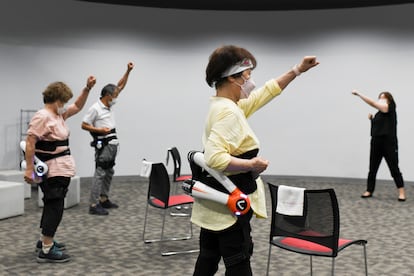
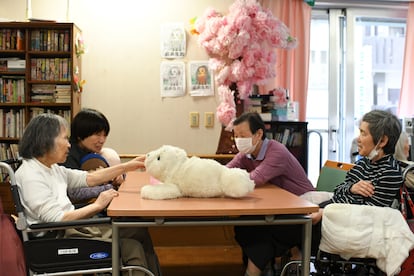
The prospect of a large number of single-person households — many of them inhabited by elderly people unable to cope with the demands of caring for a pet — opened a new market for electronics manufacturers. Sony launched a robot dog called AIBO in 1999, named after the pronunciation of the Japanese word “companion.” It weighs 4.85 pounds and, today, it’s a popular consumer product with fan clubs throughout the country. Over the course of its six generations, AIBO has evolved to achieve the appearance of a cartoon beagle puppy, with its innocent gaze beamed through two LED screens.
In long-term care residences like Shintomi, Aibo deploys its advanced facial recognition system, reacts to stimuli — such as an approving caress on the forehead — and memorizes the user’s preferences to develop a series of behaviors that could constitute a temperament. The 22 axes that articulate the components of the robot’s body allow it to walk in staggered movements, tilt its head, raise its ears, bark, whine and roll around, imitating a playful puppy. When Aibo walks through the Shintomi Nursing Home, it’s common to hear compliments as affectionate as those that would be given to a real pet.
The predisposition of the Japanese to connect emotionally with machines was explained in 2007 by the then-academic — and now businesswoman — Naho Kitano, in an essay in which she made reference to the animist tradition of Shintoism, the local religion that attributes spiritual life to inanimate objects. Experts in Japanese popular culture contrast the good-natured robots of popular Japanese manga and anime stories with the disturbing automatons that often populate Western science fiction.
For their part, the creators of AIBO point out that its design lacks the ethical considerations that are common in Western robotics, such as Isaac Asimov’s three laws for safe interaction between human beings and machines. “AIBO was created to entertain the user… give color to their life and brighten it,” says Mika Nagae, a product manager at Sony. Nagae emphasizes that the playful predominates over the utilitarian, adding that the event planner — a specialist in programming short episodes in the form of games — is very important in AIBO’s design team.
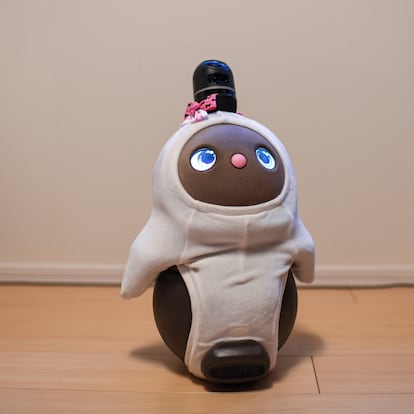
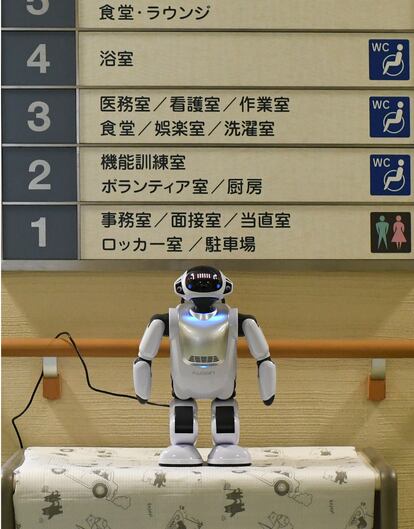
Because they’re made with molds and synthetic resins, both Pepper and AIBO are hard to the touch. Those looking for a physical experience involving soft touch and warm temperatures turn to PARO, the best-known of the Japanese social robots. Used in institutions in more than 30 countries — and classified as a medical device in some of them — the PARO robot is handmade and simulates the shape, size, color and texture of a baby harp seal. When held in your arms, it moves gently, makes realistic cooing sounds and looks at you with enormous eyes that often generate feelings of relief or tenderness in older people, including those who suffer from dementia, Alzheimer’s, or other cognitive disorders or impairments.
The creator of PARO is engineer Takenori Shibata. He speaks with EL PAÍS via video call from the United States, where he’s participating in a conference. Shibata explains that, by using the image of a seal, he sought to lower the expectations that a user may have when interacting with a pet about which he or she may have preconceived ideas, like a dog or a cat. Part of the robot’s success in international medical institutions, he adds, is due to the fact that it reduces anxiety and provides the emotional well-being of animal therapy, without the risks of infection or the associated logistical and legal difficulties.
To clarify why his creation isn’t characterized as a medical device in Japan, Professor Shibata cites one of the most important qualities of PARO: its ability to reduce the use of psychotropic medications in some treatments. “The welfare system that regulates nursing homes in Japan doesn’t distinguish between a medical device and a toy,” he explains. He also alludes to the obvious effect that the widespread use of PARO can have on the pharmaceutical business.
In Spain, CREA — a government center focused on the care of people living with Alzheimer’s disease and other types of dementia — has had a PARO unit since the facility was inaugurated in 2014. Enrique Pérez Sáez — a neuropsychologist at CREA — clarifies that the official name of the robot was changed to Nuka, since “paro” means “unemployed” or “strike” in Spanish. Dr. Pérez Sáez highlights the socializing role of the robot and the evocation of positive memories. “Nuka creates stimuli associated with the good times we’ve had with pets in our childhood,” he says.
Aside from social robots, Shintomi uses digital systems to analyze residents’ sleeping patterns, as well as devices that detect (through smell) when a diaper change is necessary. The director of Shintomi — Kimiya Ishikawa, a specialist in care for the elderly and a well-known promoter of the application of technology in geriatrics — foresees a future in which humans and machines complement each other in care work. “No human being can take care of an elderly person 24 hours a day. Only a machine can do it. The ideal is to identify each person’s strengths and work together,” he affirms.
To alleviate the task of lifting patients to clean them, Shintomi employees use exoskeletons, devices that are widely-used in industrial environments to strengthen muscles and reduce fatigue. The cutting-edge version of the exoskeleton for medical use in Japan is called HAL (Hybrid Assistive Limb). It consists of a device that — when connected to the body of a person with mobility problems — detects the signals sent by the brain to the muscles and performs the desired movement. According to its manufacturer — Cyberdyne Inc. — it can help a person living with a disability improve their physical functions even after use. In 2015, it was licensed as a medical device. “Above all, it’s aimed at increasing the independence of patients,” explains Professor Yoshiyuki Sankai, the president of Cyberdyne.
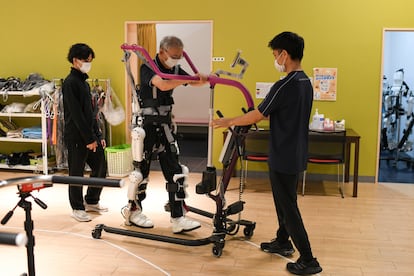
Robotics — when applied to elderly care — benefits from technological advances in the automotive sector, where the improvement of the self-driving car largely depends on the interaction between humans and machines. After 13 years as a Toyota employee and after having participated in the development of Pepper with the multinational SoftBank, engineer Kaname Hayashi decided to opt for a non-utilitarian robot that appealed to the protective instinct of human beings. He created a mascot called LOVOT (from the words “love” and “robot”).
LOVOT’s body is faithful to the Japanese kawaii esthetic. It’s cute and cuddly: it has wings and a small bump full of sensors. And, while it lacks a mouth, it’s capable of communicating joy and other emotions through enormous eyes, which are activated by liquid crystal screens. The robot’s childish appearance and the randomness of its behavior have proven to be irresistible to older people like Mrs. Mieko Shimada, a 75-year-old retiree. She tells EL PAÍS that Lovot “replaces family, children, pets… and even a partner.”
Mrs. Shimada has lived with LOVOT for the past four years in an independent apartment in a nursing home. She pampers her robot and covers it with kisses — something atypical in a society like Japan, not given to open displays of affection. “When you express admiration for someone all the time, it can come across as disingenuous. With LOVOT, I don’t feel self-conscious,” she explains.
For Hayashi — the creator of LOVOT — the popularity of robots among those residing in nursing homes is due to the decrease in self-esteem when people no longer have an obligation to care for anyone. “The more active they were before moving into the residence, the more they tend to feel like they don’t contribute,” he notes.
The technology market is expected to expand as the world’s population ages. At the moment, Japan continues to lead in life expectancy, with 87 years for women and 81 years for men. Of the country’s more than 92,000 centenarians registered last year, 88.6% were women.
Mako Kubota is the managing director of the Ryusei Fukushikai Social Welfare Corporation, in Osaka. The company has been managing nursing homes with the use of complex technologies for the past 10 years. She explains her vision of robotics in elderly care: “Exoskeletons and social robots fulfill two very different and equally important functions. Only a human being can look at a person’s face and realize that they’re not feeling well. But for repetitive or physically demanding jobs, the robot — without a doubt — is a great support.”
When asked if she foresees a near future in which the well-being of the elderly depends on humanoids and technological devices, she cites the high number of elderly men and women who, in her surveys, express their preference to be cared for by a robot. “The main reason is that they don’t want to be a burden on others,” she concludes.
Translated by Avik Jain Chatlani.
Tu suscripción se está usando en otro dispositivo
¿Quieres añadir otro usuario a tu suscripción?
Si continúas leyendo en este dispositivo, no se podrá leer en el otro.
FlechaTu suscripción se está usando en otro dispositivo y solo puedes acceder a EL PAÍS desde un dispositivo a la vez.
Si quieres compartir tu cuenta, cambia tu suscripción a la modalidad Premium, así podrás añadir otro usuario. Cada uno accederá con su propia cuenta de email, lo que os permitirá personalizar vuestra experiencia en EL PAÍS.
¿Tienes una suscripción de empresa? Accede aquí para contratar más cuentas.
En el caso de no saber quién está usando tu cuenta, te recomendamos cambiar tu contraseña aquí.
Si decides continuar compartiendo tu cuenta, este mensaje se mostrará en tu dispositivo y en el de la otra persona que está usando tu cuenta de forma indefinida, afectando a tu experiencia de lectura. Puedes consultar aquí los términos y condiciones de la suscripción digital.
More information
Archived In
Últimas noticias
The murder of Michele and Rob Reiner: A tale of horrific days in Hollywood
Trump orders a ‘complete blockade of sanctioned oil tankers’ going to and from Venezuela
Not all insomnia is the same: Study identifies five subtypes and paves the way for personalized treatment
The United States designates Clan del Golfo as a foreign terrorist group
Most viewed
- ‘El Limones’ and the growing union disguise of Mexican organized crime
- Christian Louboutin: ‘Young people don’t want to be like their parents. And if their parents wear sneakers, they’re going to look for something else’
- ‘We are dying’: Cuba sinks into a health crisis amid medicine shortages and misdiagnosis
- A mountaineer, accused of manslaughter for the death of his partner during a climb: He silenced his phone and refused a helicopter rescue
- The low-cost creative revolution: How technology is making art accessible to everyone

